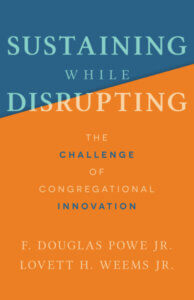Successful change requires setting priorities. But how can a leader discern which goals are most important? Doug Powe and Lovett Weems suggest a series of questions that can help reveal which initiatives can make the most difference.
Leaders routinely overreach when facing the struggles of a congregation. Instead of identifying the one innovative next step most critical for the church, the leader of the congregation may name and pursue a range of worthy innovations, with none of them receiving the required attention necessary for lasting change. Church leaders seem to think that, if they are not pursuing all the possibilities they see, their aim is too low. Quite the contrary, it is in determining what one initiative is at the heart of a more viable future for the church’s mission that true change occurs. If it is the right “new thing” a leader is pursuing, the efforts will yield far more fruit and a more varied harvest than anticipated.
In this way, the one right thing, rather than the many good things, will become something of a field of energy out of which change will come well beyond your wildest imagination. Seeking to “reach younger people” may seem like a limited effort. However, if successful, the changes required to achieve the goal and the impact of the change on the congregation will go well beyond a change in age demographics. You will have a different church. Here, a singular focus on the right thing produces missional outcomes that are unanticipated and unexpected.
Whether practicing sustaining or innovative leadership, setting a few priorities is essential. When Lovett was a seminary president, he employed a method he later came to use regularly to distinguish the big goals from among a multitude of good things. This process has to do with a series of questions to ask about everything on a list of goals to reveal where effort can make the most difference.
Key questions
1. If achieved, how much difference would it make in the quality and strength of the organization or group one year from now?
2. If achieved, how much difference would it make in the quality and strength of the organization or group five years from now?
The first two questions put each project in a longer time frame. Some things that would be good to have or to do actually won’t change the trajectory of the church.
3. How urgent is this project?
4. How vulnerable is the church if this project is not carried out?
These two questions take timing into account. Some projects would be helpful to do, but if the church does not do them in the coming year, no harm will be done. The church will be no worse for it. However, other issues are such that without immediate attention, bad consequences will come.
5. How much potential does this project have to make other things better?
New choir robes would be nice but probably would not have a ripple effect across other ministries, whereas reducing the average age of participants is likely to reverberate across virtually all aspects of the congregation.
6. How likely is success?
Success is never guaranteed, but its likelihood is one factor, among others, that should weigh into decision-making.
7. How essential is individual leadership to the success of this project?
Some efforts require a leader’s deep investment by virtue of their position, knowledge, or skills while there are also things that can just as easily be led by others. Reorganizing the children’s educational program may be a dire need but may not require the kind of attention from the pastor that a new building program will require.
Analyzing the results
Answer each of these questions with a numerical score between 1 (low) and 5 (high). Then create a simple chart in which you list your possible projects and the score for each project on each of the seven questions. Then tally the total score for each project and rank them highest to lowest.
| Projects | Question 1 | Question 2 | Question 3 | Question 4 | Question 5 | Question 6 | Totals |
| Sample Project | 5 | 3 | 2 | 5 | 1 | 3 | 24 |
This process does not cause leaders to work on nothing else but a few major goals, but these steps can identify those things needing significant attention. They also can create a lens through which to view virtually everything leaders do. Through that lens, leaders will be able to look more effectively at hiring, teaching, pastoral care, preaching, and many other aspects of pastoral leadership.
 This article is excerpted from Sustaining While Disrupting: The Challenge of Congregational Innovation by F. Douglas Powe Jr. and Lovett H. Weems Jr. Used by permission. The book is available at Fortress Press, Cokesbury, and Amazon.
This article is excerpted from Sustaining While Disrupting: The Challenge of Congregational Innovation by F. Douglas Powe Jr. and Lovett H. Weems Jr. Used by permission. The book is available at Fortress Press, Cokesbury, and Amazon.
Related Resources
- Genuine Change Involves Continuity by Doug Powe and Lovett Weems
- Four Questions for Congregations by Lovett H. Weems Jr.
- 5 Ways to Overcome Common Obstacles to Change by Daniel M. Cash and William H. Griffith







